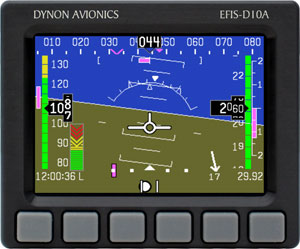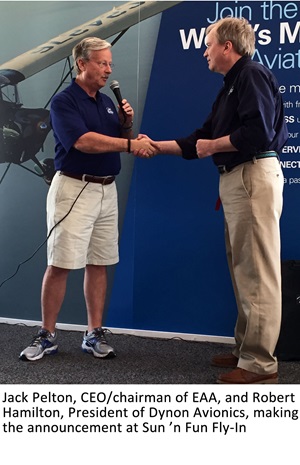EAA Partners With FAA, Dynon for STC Breakthrough to Upgrade Safety, Reduce Costs for Aircraft Owners
Flight display innovation now available for certain Cessna and Piper aircraft

April 6, 2016 — The Experimental Aircraft Association joined the Federal Aviation Administration and Dynon Avionics in announcing a breakthrough that will improve flight safety and reduce avionics upgrade costs for owners of certain type-certificated aircraft.
In making the announcement during the Sun ’n Fun Fly-In at Lakeland, Florida, EAA, FAA, and Dynon officials said they have established a supplemental type certificate (STC) process for installation of the Dynon EFIS-D10A as a replacement for the airplane’s primary attitude indicator. This allows innovations developed for the amateur-built aircraft fleet to make their way into specific Cessna and Piper models.
“Everybody involved from EAA, Dynon, and the FAA was dedicated to the success of this inaugural project, made possible by EAA’s strong working relationship with FAA’s Small Airplane Directorate,” said Jack Pelton, EAA CEO/chairman. “This STC process will allow aircraft owners to have the latest proven safety technology available in the cockpit at lower cost. I also want to emphasize that this is not an exclusive agreement; EAA and FAA are ready and eager to work with other companies to develop similar STCs for their products and expand the approved model list for additional type-certificated aircraft.”

“This cooperative effort shows how the FAA, general aviation groups, and the aviation industry can work together to benefit aircraft owners with upgraded technology, lower costs, and high levels of safety,” said Mel Johnson, manager of FAA’s Small Airplane Directorate. “This kind of partnership and innovative thinking is what is needed at all levels of aviation as we move into the future.”
The cost and application process for the STC will be finalized in the coming weeks. The STC will be available through EAA, while Dynon’s product will be available through its established distributor network and factory direct. More information is available at Dynon's website.
“For years, pilots of type certificated aircraft have been asking us for a way to install Dynon glass panel avionics in their airplane,” said Dynon President Robert Hamilton. “We jumped at the opportunity to work with EAA and the FAA to make this novel STC approach possible with our EFIS-D10A. This is a breakthrough that can lead the way for many more possibilities.”
